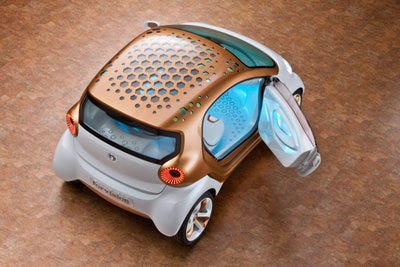BASF (Ludwigshafen, Germany) and Philips (Eindhoven, The Netherlands) have achieved a practical breakthrough in the development of OLED (organic light emitting diode) technology that allows it to be integrated in car roofs. The OLEDs are transparent when switched off, allowing for a clear view outside the vehicle, yet providing light only within the vehicle when switched on.
January 25, 2012
BASF (Ludwigshafen, Germany) and Philips (Eindhoven, The Netherlands) have achieved a practical breakthrough in the development of OLED (organic light emitting diode) technology that allows it to be integrated in car roofs. The OLEDs are transparent when switched off, allowing for a clear view outside the vehicle, yet providing light only within the vehicle when switched on.

BASF Philips OLED roof
This OLED lighting concept for car roofs is the result of a longstanding cooperation between BASF and Philips in the research and development of OLED modules. In addition to offering completely new design possibilities, the transparent OLED lighting concept also allows new approaches to automotive engineering. The transparent OLED sandwich structure can be combined with equally transparent solar cells for use as a power source."This combination allows the driver to enjoy a unique open-space feeling while it generates electricity during the day and pleasantly suffuses the interior with the warm light of the transparent, highly efficient OLEDs at night," says Felix Görth, head of Organic Light-Emitting Diodes and Organic Photovoltaics at BASF Future Business GmbH (Ludwigshafen). BASF Future Business GmbH, a wholly-owned subsidiary of BASF, was founded in April 2001. It aims to open up business areas with above-average growth rates that lie outside BASF's current activities.
Dietrich Bertram, General Manager of OLED Lighting at Philips, adds:"This project provides impressive evidence of new possibilities with OLEDs, and illustrates the potential of Philips' Lumiblade OLED technology to help create innovative lighting applications that enhance people's lives."
BASF and Philips have cooperated closely since 2006 within the OLED 2015 initiative of Germany's Federal Ministry of Education and Research (BMBF).BASF develops organo-chemical materials such as dyes that are used in the development and manufacturing of OLEDs by Philips. Working together, the two partners put the innovative transparent OLED lighting technology into practice on a car roof.
OLED technology offers the advantage of high energy efficiency, in addition to creative flexibility and new options for designers. OLED light sources are just 1.8 millimeters thin and can be transparent. The entire surface of an OLED illuminates with diffused light, making it a very soft light source that produces less harsh shadows compared to point light sources.
The joint TOPAS 2012 project was launched in January 2010, marking the second phase of the BMBF's OLED 2015 initiative. TOPAS refers to "thousand lumen organic phosphorescent devices for applications in lighting systems." In this project, the consortium partners (which include BASF and Philips) focus on developing innovative materials and component architectures as well as new production machines for lighting solutions with highly efficient organic light-emitting diodes. -[email protected]
About the Author(s)
You May Also Like


